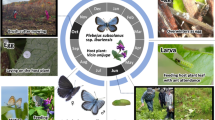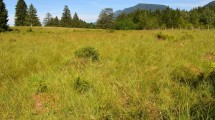Abstract
The conservation and management of endangered species requires an adequate understanding of their biology and ecology. Although there has been an increasing appreciation in Australia of the need for greater efforts to conserve insects, there is only limited information available that can be used to underpin conservation efforts. The endangered golden sun moth, Synemon plana (Lepidoptera: Castniidae) is a flagship species endemic to natural temperate grassland in south-eastern Australia. Most populations of this species are at considerable risk from habitat loss, weed invasion and inadequate management. Despite the considerable knowledge that exists about the species biology and ecology, efforts to improve the species conservation status are hampered because there are still critical gaps in our understanding of the species’ natural history. In particular, the ecology of the larvae is not known. Our study examined the abundance, population structure and reproductive biology of the moths in a broad sample of both natural temperate and exotic grassland remnants in and near Canberra in the Australian Capital Territory (ACT) in south-eastern Australia. The results fill critical gaps in the knowledge needed to achieve effective conservation management. From our findings, it is clear that the species inhabits grasslands dominated by a mixture of native wallaby grasses (Rytidosperma spp. (formerly Austrodanthonia)) and spear grasses (Austrostipa spp.). In contrast to earlier suggestions that S. plana is entirely confined to natural temperate grassland, mature and immature life stages of the species were also present in grasslands comprised entirely of the exotic Chilean needlegrass (Nassella neesiana). Most of the S. plana populations surveyed in the ACT were characterised by low relative abundance with only very few large populations being recorded. The conservation of exotic grasslands as substitute habitat for S. plana is discussed and suggestions regarding future monitoring and research of the species are provided.







Similar content being viewed by others
References
ACT Government (2005) A vision splendid of the grassy plains extended: ACT Lowland Native Grassland Conservation Strategy. Action Plan No. 28 Department Arts Heritage and Environment, Canberra
Australian Government (2009) EPBC act list of threatened fauna. Department of Sustainability, Environment, Water, Populations and Communities. Canberra, ACT
Australian Government (2012) Synemon plana in species profile and threats database, Department of Sustainability, Environment, Water, Population and Communities, Canberra. Available from: http://www.environment.gov.au/sprat (download February 2013)
Australian Weeds Committee (2012) Weeds of National Significance 2012. Department of Agriculture, Fisheries and Forestry, Canberra, ACT. http://www.weeds.org.au/WoNS/. (download February 2013)
Benson J (1996) What is a native grassland? In: Eleventh annual conference grassland society NSW, pp 92–96
Braby MF, Dunford M (2006) Field observation on the ecology of the golden sun moth, Synemon plana Walker (Lepidoptera: Castniidae). Aust Entomol 22:103–110
Bremer K (2002) Gondwanan evolution of the grass alliance of families (Poales). Evolution 56:1374–1387
Bremer K, Janssen T (2006) Gondwanan origin of major monocot groups inferred from dispersal-vicariance analysis. Aliso 22:22–27
Brown G, Tolsma A, McNaab E (2012) Ecological aspects of new populations of the threathened golden sun moth ‘Synemon plana’ on the Victorian Volcanic plains. Vic Nat 129:77–85
Bureau of Meteorology (2010) http://www.bom.gov.au/nsw/canberra/climate.shtml
Clarke GM (2000) Inferring demography from genetics: a case study of the endangered golden sun moth, Synemon plana. Genet Demogr Viability Fragm Popul 4:213–225
Clarke GM, Dunford M (1999) Survey of the Belconnen Naval Transmitting Station for the endangered golden sun moth, Synemon plana. Environment ACT, Canberra
Clarke GM, O’Dwyer C (2000) Genetic variability and population structure of the endangered golden sun moth, Synemon plana. Biol Conserv 92:371–381
Clarke GM, Whyte LS (2003) Phylogeography and population history of the endangered golden sun moth (Synemon plana) revealed by allozymes and mitochondrial DNA analysis. Conserv Genet 4:719–734
Connor EF, Faeth SH, Simperloff D, Opler PA (1980) Taxonomic isolation and the accumulation of herbivorous insects: a comparison of introduced and native trees. Ecol Entomol 5:205–211
Cook L, Edwards ED (1993) Population monitoring of endangered moth Synemon plana 1992–1993, York Park, Barton. CSIRO Australia. Report to the National Capital Planning Authority, Canberra
Cook L, Edwards ED (1994) Population monitoring of endangered moth Synemon plana 1993–1994, York Park, Barton. CSIRO report to the National Capital Planning Authority, Canberra
CSIRO (2007) Climatic changes—Australia. Technical report. http://www.climatechangeinaustralia.gov.au/technical_report.php (download February 2013)
Danilevskii AS (1965) Photoperiodism and seasonal development of insects. Oliver and Boyd, London
DSE (2009) Background Paper to EPBC Act Policy Statement 3.12 - Significant impact guidelines for the critically endangered Golden Sun Moth (Synemon plana). Department of the Environment, Water, Heritage and the Arts, Canberra, ACT. Available from: http://www.environment.gov.au/epbc/publications/pubs/background-paper-golden-sun-moth.pdf. (Ed. W Department of the Environment, Heritage and the Arts)
Edwards ED (1993) Synemon plana site, Belconnen Naval Base, Lawson. In: Morl Grasslands (ed) Proceedings of a workshop and public seminar. September 24 & 25 1993. Canberra, pp 150–152. (ACT Parks and Conservation Service, Canberra)
Edwards ED (1994) Survey of lowland grassland sites in the A.C.T. for the golden sun moth Synemon plana. (Unpublished report to Wildlife Research Unit. ACT Parks and Conservation Services: Canberra)
Friberg M, Wiklung C (2010) Host-plant-induced larval decision-making in a habitat/host-plant generalist butterfly. Ecology 91:15–21
Friberg M, Dahlerus J, Wiklund C (2012) Strategic larval decision-making in a bivoltine butterfly. Oecologia 169:623–635
Gibson L, New TR (2007) Problems in studying populations of the golden sun-moth, Synemon plana (Lepidoptera: Castniidae), in south eastern Australia. J Insect Conserv 11:309–313
Gilmore D, Harvey A (2010) Golden sun moth review and advice to the Growth Areas Authority. Report to Growth Areas Authority. Biosis Research, Port Melbourne
Gilmore D, Koehler S, O’Dwyer C, Moore W (2008) Golden sun moth Synemon plana (Lepidoptera: Castniidae): results of a broad survey of populations around Melbourne. Vic Nat 125:39–46
Gotthard K (2008) Adaptive growth decisions in butterflies. Bioscience 8:222–230
Gunn RH, Story R, Galloway RW, Duffy PJB, Yapp GA, McAlpine JR (1969) Lands of the Queanbeyan-Shoalhaven Area, ACT and NSW. CSIRO Land Res Ser 24:113–133
Kirkpatrick J, McDougall K, Hyde M (1995) Australian’s most threatened ecosystems the southeastern lowland native grasslands. Surry Beatty & Sons, Chipping Norton
Lettink M, Armstrong D (2003) An introduction to using mark-recapture analysis for monitoring threatened species. Department of Conservation, Wellington, New Zealand
McDougall K, Kirkpatrick J (1994) Conservation of lowland native grasslands and grassy woodlands in South-eastern Australia. World Wide Fund for Nature Australia, Sydney
Mitchell M (2003) Native grasses: an example of using on-farm biodiversity. In: Crosthwaite J, Farmar-Bowers Q, Hollier C (eds) Land-use changes—YES—but will biodiversity be OK? p. 11. Department of Sustainability and Environment, Victoria
New TR (2012) The golden sun moth, Synemon plana Walker (Castniidae): continuing conservation ambiguity in Victoria. Vic Nat 129:109–113
Nowicki P, Settele J, Henry P-Y, Woyciechowski M (2008) Butterfly monitoring methods: the ideal and the real world. Israel J Ecol Evol 54:69–88
O’Dwyer C, Attiwill PM (1999) A comparative study of habitats of the golden sun moth Synemon plana WALKER (Lepidoptera: Castniidae): implications for restoration. Biol Conserv 89:131–142
O’Dwyer C, Attiwill PM (2000) Restoration of a native grassland as habitat for the golden sun moth Synemon plana Walker (Lepidoptera; Castniidae) at Mount Piper, Australia. Restor Ecol 8:170–174
Pollard E, Yates TJ (1993) Monitoring butterflies for ecology and conservation. The British Butterfly Monitoring Scheme. Chapman & Hall, London
Richter A (2010) What makes species vulnerable to extinction following habitat fragmentation and degradation? A test using the insect fauna in native temperate grasslands in south-eastern Australia. University of Canberra, PhD thesis
Richter A, Osborne WS, Robertson G, Hnatiuk S (2009) Community monitoring of golden sun moths in the Australian Capital Region, 2008–2009. Report prepared for WWF Australia. University of Canberra, Institute for Applied Ecology, Canberra, Australia
Richter A, Weinhold D, Robertson G, Young M, Edwards T, Hnatiuk S, Osborne W (2012) More than an empty case: a non invasive technique for monitoring the Australian critically endangered golden sun moth, Synemon plana (Lepidoptera: Castniidae). J Insect Conserv (online first). doi:10.1007/s10841-012-9537-5
Rowell A (2012) Block 3, section 22 Barton, ACT. Five-year monitoring event for golden sun moth and condition assessment of natural temperate grassland. Report to Report to Department of Finance and Deregulation, Canberra
Rutowski RL, Demlong MJ, Lenffingwell T (1994) Behavioural thermoregulation at mate encounter sites by male butterflies (Asterocampa leilia, Nymphalidae). Animal Behav 48:833–841
Schultz CB, Hammond PC (2003) Using population viability analysis to develop recovery criteria for endangered insects: case study of the Fender’s blue butterfly. Conserv Biol 17:1372–1385
Schwarz CJ, Arnason AN (1996) A general methodology for the analysis of capture-recapture experiments in open populations. Biometrics 52:860–873
Sharp S (1993) Floral diversity in lowland native grassland in the ACT. In: Sharp S, Rehwinkel R (eds) Management of relict lowland grasslands. Canberra, pp 80–88. (Conservation Series No. 8, ACT Parks and Conservation Service)
Sharp S, Shorthouse DJ (1996) Native grasslands and threatened species in the Australian Capital Territory. Steps towards protection and recovery. In: Stephens S, Maxwell S (Eds) Back from the brink: refining the threatened species recovery process. Surrey Beatty & Sons, Chipping Norton, pp 138–149
Van Der Have TM (2002) A proximate model for thermal tolerance in ectotherms. Oikos 98:141–155
Van Swaay CAM, Van Strien AJ (2005) Using butterfly monitoring data to develop a European grassland butterfly indicator. In: Kuehn E, Thomas JA, Feldmann R, Settele J (eds) Studies on the ecology and conservation of Butterflies in Europe. Vol 1 general concepts and case studies. Pensoft, Sofia, pp 106–108
White GC, Burnham KP (1999) Program MARK: survival estimation from populations of marked animals. Bird Study 46(Supplement):120–138
Acknowledgments
First and foremost, we thank the many volunteers who contributed to the success of the community project. We also thank Kim Pullen (CSIRO Entomology), Isobel Crawford (National Herbarium of Australia), Alan Yen (Primary Industries Victoria), Daniel Gilmore (Biosis Melbourne), Dana Weinhold and Sylvio Teubert for species identification and species ecology related discussions, field work, administrative assistance and comments on the manuscript. Statistical advice was received from Bernd Gruber and David Peterson (both University of Canberra). Anett Richter was supported by the UC International Postgraduate Scholarship. The ‘Sun Moth count’ project was financially supported by the World Wide Fund for Nature and the ACT Government. Facilities were provided by the Institute for Applied Ecology at the University of Canberra. Parsons Brinckerhoff and the Department of Finance commissioned A. Rowell to conduct the MRR study in 2007 and kindly permitted the publication of the results. Permission to undertake this research was provided by the ACT Government. Finally, we thank Michael Braby and one anonymous reviewer for providing valuable comments and suggestions to improve the paper.
Author information
Authors and Affiliations
Corresponding author
Rights and permissions
About this article
Cite this article
Richter, A., Osborne, W., Hnatiuk, S. et al. Moths in fragments: insights into the biology and ecology of the Australian endangered golden sun moth Synemon plana (Lepidoptera: Castniidae) in natural temperate and exotic grassland remnants. J Insect Conserv 17, 1093–1104 (2013). https://doi.org/10.1007/s10841-013-9589-1
Received:
Accepted:
Published:
Issue Date:
DOI: https://doi.org/10.1007/s10841-013-9589-1




